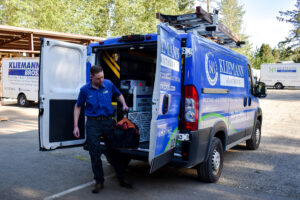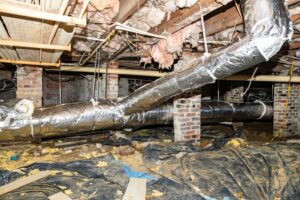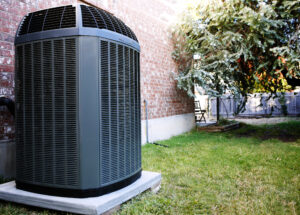8 Factors That Affect AC Installation Cost

When your AC conks out in the middle of July or you’re trying to figure out what a new system will cost, getting a straight answer about an AC installation cost estimate can feel like an impossible task. After years of helping people through this process, we at Kliemann Brothers have learned that most individuals simply want to know what they’re really looking at in terms of cost. So how much does it cost to install a new AC? Well, there’s no straightforward answer. The average cost of installing an AC unit in 2025 is $6,096. Split ACs average $4,133. However, depending on the system’s size and configuration, the cost can exceed $16,000.

1. Type of AC System
Think of buying a new AC system like purchasing a car. You’ve got your basic models and your luxury versions, and they all do the job differently.
Central AC vs. Ductless Mini-splits vs. Packaged Systems
Central AC is what most people think of when they picture home cooling. These systems work great if you already have ductwork in your house, as they simply plug in and work with what’s already there.
If your house doesn’t have ducts or you want to cool specific rooms, ductless mini-splits are a great design. Minisplits are also an excellent choice for room additions and small apartments, where extending or installing ductwork for a central air conditioner is impractical.
Overview of Price Ranges for Each
You’re likely looking at a cost of $5,000 to $12,000 for the entire central AC installation. For ductless mini-splits, each indoor unit runs about $2,000 to $5,000, plus you need the outdoor unit. This sounds reasonable until you realize you might need four or five of those indoor units to cool your whole home.
2. Home Size and Layout
Home size is among the most important factors when selecting an AC. Generally, the larger your home, the bigger and more expensive an air conditioner you’ll need. Residential AC installation in older homes can get interesting. We need to think creatively about how we run refrigerant lines and find suitable locations for the equipment. Sometimes the perfect spot for your outdoor unit is on the opposite side of the house from your electrical panel, and suddenly we’re talking about more costly electrical work.
3. Size and Cooling Capacity of the Unit
You also don’t want to undersize your AC, as this will result in short cycling and increased energy strain, leading to higher energy bills.
Here’s a look at AC capacity and home size vs. average costs:
- 1.5 Tons (18,000 BTUs/Hour): Accommodates a 750- to 900-square-foot home and costs $2,500 to $4,500 on average.
- 2 Tons (24,000 BTUs/Hour): Accommodates a 1,000- to 1,200-square-foot home and costs $3,100 to $5,100 on average.
- 3 Tons (48,000 BTUs/Hour): Accommodates a 1,500- to 1,800-square-foot home and costs $3,400 to $5,400 on average.
- 4 Tons (48,000 BTUs/Hour): Accommodates a 2,000- to 2,400-square-foot home and costs $4,200 to $6,200 on average.
The new air conditioner cost goes up with size, but it’s not always what you’d expect. Sometimes a bigger unit only costs a few hundred more.
To determine the correct air conditioner size needed for your space, a technician from Kliemann Brothers will perform a Manual J load calculation. This takes factors such as insulation, wall types, square footage, and window coverings into account to determine the exact size needed to cool your home efficiently. Look at this step-by-step guide for a new AC installation.

4. Ductwork Condition and Modifications
If your ducts are in good shape and the right size, you’re golden. But if they’re leaky, too small, or simply not suitable for your new system, we have work to do. Inadequate ductwork can kill your efficiency by 20% or more. Fixing ducts might add $1,000 to $3,000. If we need to start over completely, you can expect an additional $5,000 to $10,000. Switching from just heating to adding AC usually means we need more return air ducts.
5. Energy Efficiency (SEER Ratings)
Efficiency is measured using an air conditioner’s seasonal energy-efficiency rating (SEER). The lowest allowable rating is 14 SEER (it’s 15 SEER in southern regions of the U.S.). Some ACs are rated as high as 27 SEER.
Those super high-efficiency 20+ SEER units are impressive, but you’re paying premium prices for that top-tier efficiency. Most people find that the 16-18 SEER range is the ideal range. As of 2023, newer models are now rated with SEER2 rating system for maximum efficiency.
6. Labor, Permits, and Local Regulations
An HVAC contractor may charge a flat rate for labor or an hourly fee. The cost can add up, as air conditioning installation can take many hours. Local regulations also come into play. AC installation in Puget Sound, WA, for example, reflects the cost of living and working in the area, as well as all the local regulations we must follow. Permits typically range from $50 to $300, depending on the requirements of your city or county. We manage all the necessary paperwork, which is included in the services you are paying for. Some places require electrical permits, some need mechanical permits, and some require both. Some neighborhoods have noise regulations regarding the placement of outdoor units as well. We handle all of these little factors.
7. Thermostats and Smart Controls
Modern thermostats can add anywhere from $200 to $1,500 to your AC unit replacement cost. Basic programmable ones let you set schedules, which is handy, but smart thermostats let you control everything from your phone, learn your habits, and show you exactly where your energy dollars are going. If you travel frequently or have a constantly changing schedule, being able to adjust your thermostat from anywhere is helpful.
8. Additional Upgrades or Accessories
Air purifiers, UV lights, better filters, and humidity control — each one of these additional upgrades serves a purpose, but they all add to the bill, too. For completely clear indoor air, whole-house air purifiers range from $500 to $2,500, depending on the type and the level of coverage required. UV lights for killing germs typically range from $400 to $800. High-end filtration systems add $300 to $1,000.
Zoning systems are also a significant upgrade, typically adding $2,000 to $5,000. These allow you to control different parts of your house separately, which is great for two-story houses or rooms that are always too hot or cold.
Tips for Getting an Accurate AC Installation Quote
Any decent HVAC installation cost breakdown should clearly outline equipment costs, labor, permits, and any additional expenses you’re incurring. Kliemann Brothers provides a written estimate and ensures that you understand all the factors affecting HVAC costs, aiming to make the AC installation affordable within your budget.

Call Kliemann Brothers for an AC Installation Cost Estimate
Here at Kliemann Brothers, we’ll walk you through all your options, explain the costs of replacing your HVAC system, and help you find something that actually makes sense for your house and your budget.
Don’t wait until your old system dies to start thinking about replacement. Emergency installs always cost more and limit your choices. Give us a call, and we’ll give you a straight answer about what it’ll take to keep you cool.

